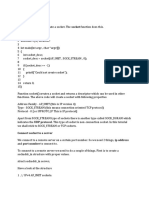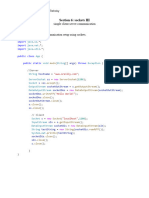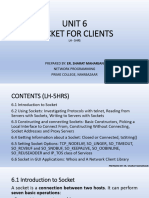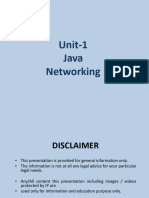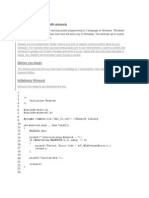Ruby Socket Programming Cheat Sheet
Uploaded by
ÉderRuby Socket Programming Cheat Sheet
Uploaded by
ÉderRuby Socket Programming Cheat Sheet
Server Lifecycle
server = Socket.new(:INET, :STREAM) addr = Socket.sockaddr_in(1337, '0.0.0.0') server.bind(addr) server.listen(Socket::SO_MAXCONN) connection, _ = server.accept
Reminders
# create # bind # listen # accept
EOF: a condition where no more data can be sent on an IO. Errno::EAGAIN: the one that gets raised when a non-blocking operation would otherwise block. Socket::SOMAXCONN: the maximum number of connections that may be queued on a socket. Pass this to listen(). IO.select: can tell you when a socket is readable or writable. Use this to implement socket timeouts.
# The Ruby Way server = TCPServer.new(1337)
Client Lifecycle
client = Socket.new(:INET, :STREAM) # create addr = Socket.sockaddr_in(80, 'google.com') client.connect(addr) # connect
# The Ruby Way client = TCPSocket.new('google.com', 80)
Reading
socket.read socket.read(1024) socket.readpartial(1024) socket.read_nonblock(1024)
# # # #
read read read read
until EOF until EOF or 1024 bytes received <= 1024 bytes or until EOF <= 1024 bytes. raises Errno::EAGAIN when there's no data
Writing
socket.write('stuff') # write data, returns number of bytes written socket.write_nonblock('stuff') # same as above, but raises Errno::EAGAIN if write(2) would block
Timeouts
timeout = 5 begin socket.read_nonblock(1024) rescue Errno::EAGAIN # raised when the read(2) would otherwise block if IO.select([socket], nil, nil, timeout) retry else raise Timeout::Error end end
Manpage Sections
Section 1: General Commands Section 2: System Calls Section 3: C Library Functions Section 4: Special Files (Devices) Section 5: File Formats Section 6: Games/Screensavers Section 7: Miscellaneous Section 8: Admin Commands Use them! And try man 2 intro.
Socket Options
socket.getsockopt(:SOCKET, :TYPE) # Get the type (:STREAM, :DGRAM, etc) socket.setsockopt(:TCP, :NODELAY, true) # Turn off Nagle's algorithm socket.setsockopt(:SOCKET, :SNDBUF, 10) # That's a tiny send buffer! socket.setsockopt(:SOCKET, :REUSEADDR, true) # Reuse recently closed ports
By Jesse Storimer - jstorimer.com
You might also like
- Open Source Intelligence (Osint) : An Oxymoron?: International Journal of Intelligence and CounterintelligenceNo ratings yetOpen Source Intelligence (Osint) : An Oxymoron?: International Journal of Intelligence and Counterintelligence19 pages
- Techniques of Java Programming: Sockets in Java: Manuel Oriol May 10, 2006No ratings yetTechniques of Java Programming: Sockets in Java: Manuel Oriol May 10, 20068 pages
- Ocket-Server.c: Int Void Int Struct Char IntNo ratings yetOcket-Server.c: Int Void Int Struct Char Int8 pages
- Python - Making A Fast Port Scanner - Stack OverflowNo ratings yetPython - Making A Fast Port Scanner - Stack Overflow8 pages
- Python Socket - Network Programming TutorialNo ratings yetPython Socket - Network Programming Tutorial18 pages
- Winsock Tutorial Socket Programming in C On Windows Binary TidesNo ratings yetWinsock Tutorial Socket Programming in C On Windows Binary Tides17 pages
- Raport: Ministerul Educației Al Republicii Moldova Universitatea Tehnică A MoldoveiNo ratings yetRaport: Ministerul Educației Al Republicii Moldova Universitatea Tehnică A Moldovei17 pages
- Exno2 Introduction To Socket Programming Aim: To Study About The Basics of Socket in Network ProgrammingNo ratings yetExno2 Introduction To Socket Programming Aim: To Study About The Basics of Socket in Network Programming20 pages
- Eyuel Tesfaye 0014 (Socket Programming)No ratings yetEyuel Tesfaye 0014 (Socket Programming)10 pages
- NP-Section7-Network Data and Network ErrorsNo ratings yetNP-Section7-Network Data and Network Errors18 pages
- C Socket Programming For Linux With A Server and Client Example CodeNo ratings yetC Socket Programming For Linux With A Server and Client Example Code5 pages
- Network Programming - Server & Client PythonNo ratings yetNetwork Programming - Server & Client Python14 pages
- How The Communication Occurs?: PC ClientNo ratings yetHow The Communication Occurs?: PC Client20 pages
- Web - Cs.wpi - Edu Rek Grad Nets Spring2012 TCP Sockets S12 PDFNo ratings yetWeb - Cs.wpi - Edu Rek Grad Nets Spring2012 TCP Sockets S12 PDF22 pages
- Lab 1: Client and Server Programs: ObjectiveNo ratings yetLab 1: Client and Server Programs: Objective6 pages
- p59 0x0a Execution Path Analysis Finding Kernel Rootkits by J.K.rutkowskiNo ratings yetp59 0x0a Execution Path Analysis Finding Kernel Rootkits by J.K.rutkowski22 pages
- Java Network - Programming Examples: SolutionNo ratings yetJava Network - Programming Examples: Solution14 pages
- Pemrograman Jejaring Komputer: Pertemuan 6 Oleh: Herman, Skom., MMNo ratings yetPemrograman Jejaring Komputer: Pertemuan 6 Oleh: Herman, Skom., MM42 pages
- Build your own Blockchain: Make your own blockchain and trading bot on your pcFrom EverandBuild your own Blockchain: Make your own blockchain and trading bot on your pcNo ratings yet
- Understanding Software Engineering Vol 3: Programming Basic Software Functionalities.From EverandUnderstanding Software Engineering Vol 3: Programming Basic Software Functionalities.No ratings yet
- Accepted Manuscript: Digital Communications and NetworksNo ratings yetAccepted Manuscript: Digital Communications and Networks14 pages
- Machine Learning For Web Vulnerability Detection: The Case of Cross-Site Request ForgeryNo ratings yetMachine Learning For Web Vulnerability Detection: The Case of Cross-Site Request Forgery9 pages
- Allama Iqbal Open University, Islamabad: (Department of Computer Science)No ratings yetAllama Iqbal Open University, Islamabad: (Department of Computer Science)2 pages
- Computer Networks - A Top Down Approach: Notes (Chapters 1, 2, 3, 9)No ratings yetComputer Networks - A Top Down Approach: Notes (Chapters 1, 2, 3, 9)69 pages
- EE450 Socket Programming Project Fall09No ratings yetEE450 Socket Programming Project Fall0913 pages
- Red Hat Subscription Management-1-Subscription Concepts and Workflows-En-USNo ratings yetRed Hat Subscription Management-1-Subscription Concepts and Workflows-En-US39 pages
- IDEA StatiCa Licenses Support Error Messages and TipsNo ratings yetIDEA StatiCa Licenses Support Error Messages and Tips16 pages
- Study of Socket Programming and Client SNo ratings yetStudy of Socket Programming and Client S4 pages
- Modeling and Real-Time Simulation Architectures FoNo ratings yetModeling and Real-Time Simulation Architectures Fo15 pages
- Application Layer: Reading Chapter 7 Computer Networks, TanenbaumNo ratings yetApplication Layer: Reading Chapter 7 Computer Networks, Tanenbaum61 pages
- Manual: Lynxmotion Visual Sequencer V1.16No ratings yetManual: Lynxmotion Visual Sequencer V1.1620 pages
- L503C-Y (L511C-Y) Custom AT Command User Guide V1.4No ratings yetL503C-Y (L511C-Y) Custom AT Command User Guide V1.444 pages























